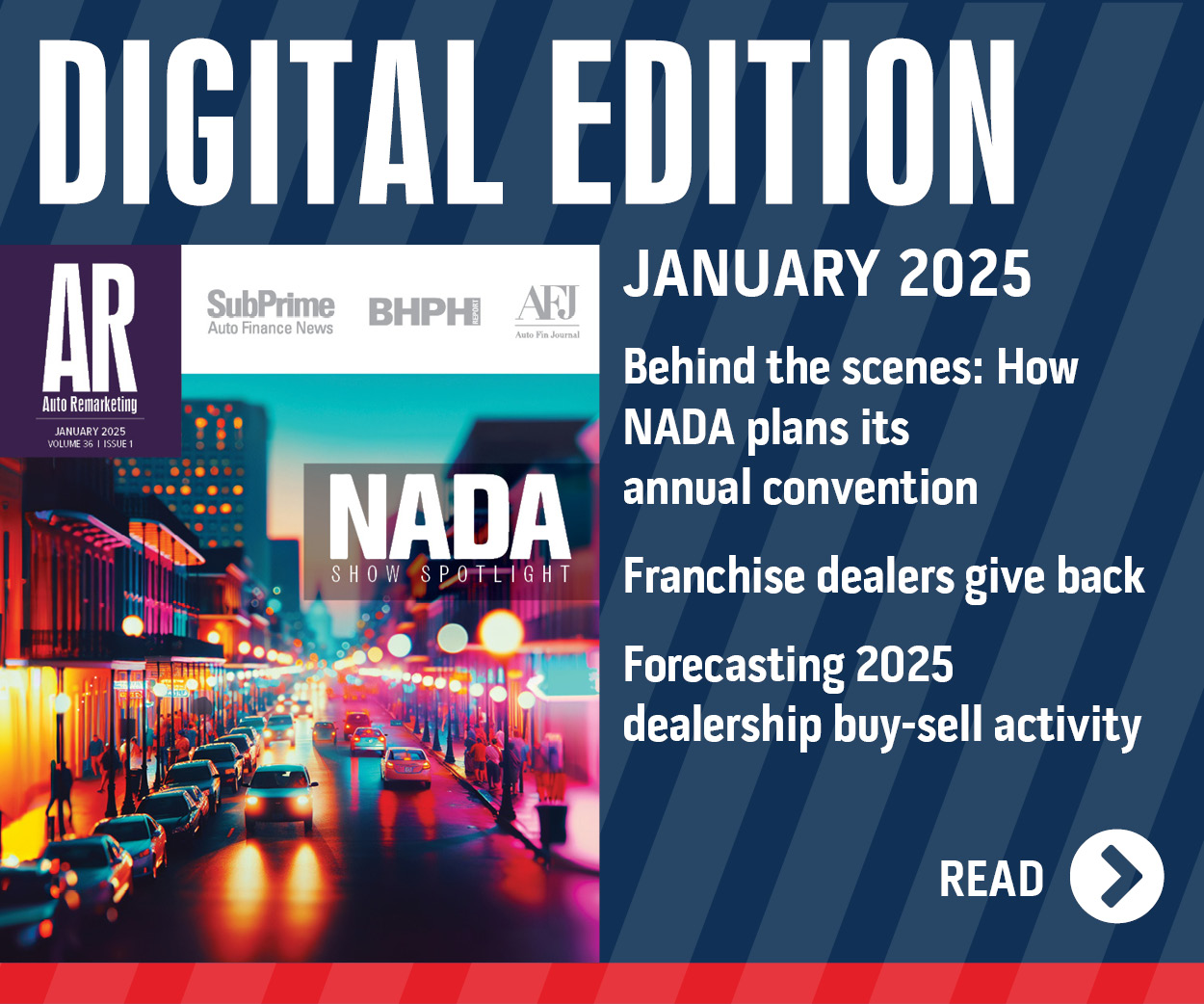4 Core Characteristics of the Top Used-Car Dealer

There are thousands of miles between the Keyes Automotive Group in Van Nuys, Calif., and the Serra Automotive Group in Birmingham, Ala.
But the one thing these two dealership groups have in common — and 123 other dealership groups from Maine to Malibu — was their membership in last year’s Auto Remarketing feature “The Top 125 Used Car Dealer Groups.”
Similarly, this year Auto Remarketing looks at high-ranking dealers and dealer groups in its “The Best in Pre-Owned Performance” feature, which includes top performers from coast-to-coast and everywhere in between.
These rankings are certainly important, but they are not the only ways to evaluate or measure a top-rated used-car dealer group. Looking at this group another way, we found four characteristics or elements critical and common to all of these top dealerships. They are:
- The Product Assortment
- The Culture of The Dealership
- Customer Service Re-Defined
- Innovative Processes and Technologies
Let’s look into these characteristics further
1. Product & Price Assortment
Today, there are more than 250 million cars on the road in the United States, and every one of them is used. Even if we were to “consider the 14.5 million new vehicles retailed in 2012 as still new, the number of used vehicles on the road today still dwarfs the number of new,” says Tom Webb, of Manheim Consulting. According to AAA in its most recent findings, the average age of all cars currently on U.S. roads is 11 years old, up from about 9.4 years in 2009 and 8.4 years in 1995
As year-end and first-quarter results were recently reported, conditions seem fairly positive for increased sales throughout the used car retail market.
In an Auto Industry Brief, Webb wrote “Although gross margins continue to show their long-term drift down, efficiencies are leading to record profits.”
One such efficiency is the positioning of dealer inventory on the Internet. Today, the Web portals generate the leads and dealer support software and salesmanship secure the deal.
One such company, Black Book, uses its portfolio analysis to help dealers get up to the minute pricing. If a dealer has 100 cars and $1 million in inventory, Black Book’s Ricky Beggs says “they can get overnight price estimates on every car in stock and decide whether to increase the price or cut it loose.”
Top-rated dealers use these tools and many more to buy and sell aggressive amounts of inventory. They are risk takers and understand the market is good for used-car sales, and use market tools, barometers and criteria to optimize their sales and margins. They are confident in their systems and people to do this.
2. The Culture Of The Dealership (The Workplace)
Steve Cannon, president and chief executive officer of Mercedes-Benz USA, believes that the customer experience begins with a workplace culture.
At the 2013 NADA Convention & Expo, he rolled out a universal plan for dealers to focus on customer services, and, as he put it, “it starts by changing the culture,” according to a story this year on www.fi-magazine.com.
Two years ago, he started to do just that — by conducting an annual culture survey. Here’s more of what the story had to say:
The survey was designed to identify changes needed to improve the workplace environment. Since the survey’s implementation, Mercedes-Benz has gone from No. 49 on FORTUNE magazine’s 2010 Best Workplaces to No. 12 in 2012.
Part of Cannon’s strategy called for the deployment of a dealer engagement survey to help dealers determine employee issues within their own organization. The initial findings were brutal, with only 63 percent of employees reporting to be “engaged” in their job, 28 percent were “not engaged” or close to apathetic and 9 percent were flat out “disengaged.”
Additionally, Mercedes-Benz found that the most engaged dealerships were the most profitable. The high return on investment proved to Cannon that culture really matters. “It affects the bottom line,” he says. Cannon referred to his plan as a “leap of faith you make when people start mattering more than process.”
In a customer service culture, trust is of the upmost importance in the customer and employee relationship. In the perfect setting, management must trust employees; employees must trust management; and the customer must trust the company.
At these top-rated dealers there may well be competition. But this competitive spirit breeds success, and the general managers use this to fuel trust drive sales, not to divide and conquer. With or without the sophisticated feedback tools of Mercedes, this type of trusting workplace is what helps to distinguish these top performing dealerships.
3. Customer Service Re-Defined At The Dealership Level
Cannon also took on the challenge to redefine the Mercedes-Benz customer experience. He knew that the level of engagement between his employees and his customers are the fundamental determinants of how a customer will perceive a company.
Two programs he launched to improve the customer experience were the Driven to Lead program where 11,000 customer-facing employees attended a “boot camp” last year, and the other program he launched was the Drive a Star Home program. This program was established after discovering that 70 percent of their dealership employees had never driven a Mercedes-Benz.
Cannon authorized that a fleet of more than 700 cars was to be taken to local dealerships this year so employees could drive them for a few days. He said “this is the kind of investment that you can only make if culture matters”.
Shep Hyken, customer service expert, also believes an amazing customer service culture begins by first amazing the employees. When discussing Ace Hardware, Hyken commends them for being a perfect role model for their chain of retail stores known for their helpful service.
Their tag line is “The Helpful Place”, and he says “they have operationalized the word helpful into their culture. That is their version of customer service. Helpful is what gives them a competitive edge. That’s how they compete with stores like Home Depot and Lowes.”
It’s their culture. It is the reason they exist. They hire the right people to fit into the culture. They train them both technically and on how to deliver their brand of helpful customer service. And the secret to their success is that they focus on their employees first, then their customers.
4. Innovative Processes and Technologies
To industry experts and technology analysts, it comes as no surprise that this decline in the number of drivers began accelerating starting in 1998 — about the same time AOL chat rooms, email and mobile phones began to make their mark.
With massive strides in technology over the last decade, young people now have their iPads, laptops and every other sleekly designed, Web-connected device. Social networking, though, isn’t the only online phenomenon making the car obsolete to some younger people. The explosion in online commerce has decreased the need to take a car trip to the mall.
A new car-shopping process has been evolving ever since the explosion of Internet car-shopping sites such as leaders like AutoTrader.com, Cars.com and newcomers like AutoRef.com, who is connecting forward-thinking dealers and savvy car buyers With sites like these, consumers have a whole new world at their fingertips.
In fact, research shows 49 percent of people cite the Internet as their biggest influence on their car make/model decision — nearly 30 percent more than any other factor, including advice from friends and family. Only 13 percent of consumers rank preexisting knowledge as their top influence.
Dealerships are working with companies that offer a value added win-win. For example, five years ago very few dealerships were actively getting consumer reviews. While that number is still relatively small, websites like DealerRater.com and Women-Drivers.com offer tremendous upside for dealers to market their rankings and scores to draw new customers.
Though not “technically” a lead generating site, Women-Drivers.com hears from dealerships everyday who want to distinguish and market their stores as being CERTIFIED.
Most dealerships are also making their website reformatted to help mobile customers identify both cars and car stores. Customers can hypothetically stand on one dealer’s used-car lot looking at a 2010 Volkswagen Jetta, then pull up a website on their smartphone and identify all the dealerships within a designated radius to see comparable models are for sale.
Top-rated dealers do not shy away from “trying” on various digital innovations in all areas of their business – from marketing, lead gen, finance, service, Web, dealer reviews, scheduling, SEM, SEO and social media, etc. They are using cutting edge digital services to reach new customers every day.
Editor’s Note: Anne Fleming is president and car-buying advocate at Women-Drivers.com, and a guest contributor for Auto Remarketing.

 View The Latest Edition
View The Latest Edition

